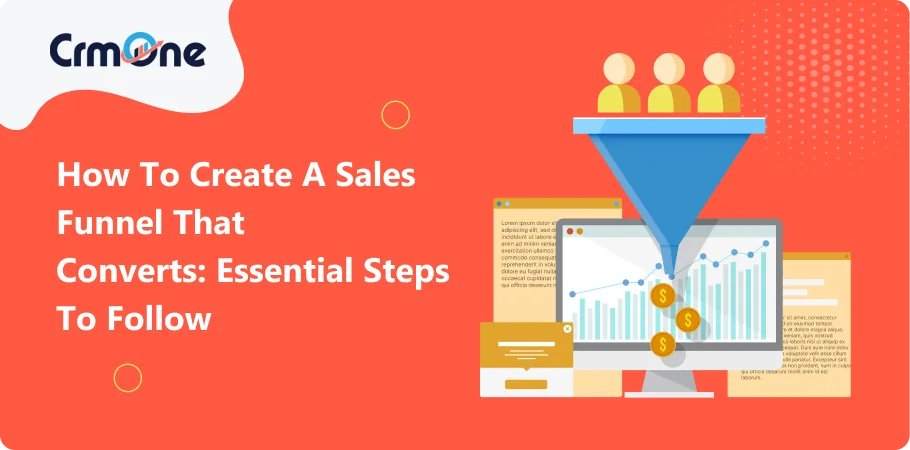Understanding marketing terms or sales funnels is essential in the vast business landscape. A sales funnel guides people from merely hearing about your product to purchasing it. It’s a step-by-step process where potential customers progress through different stages before buying. In addition to the sales funnel – marketing term, understanding the marketing funnel concept is crucial. A marketing funnel is a strategic structure that directs potential customers through the various stages of the customer journey, from awareness to making a purchase decision. By integrating the marketing funnel with your sales funnel, you can increase the conversion rate from the first interaction with your brand to when they become paying customers.
Imagine this: Someone visits your website’s landing page but waits to buy anything immediately. This is where the sales funnel management comes into play. It helps you establish trust with them over time so they eventually feel comfortable making a purchase. It is crucial for businesses of all sizes as it helps convert curious visitors into qualified leads. To enrich the effectiveness of your sales funnel, integrating a company’s sales model or a marketing funnel into your overall strategy can further amplify your results. A marketing funnel complements the sales funnel by attracting potential leads, nurturing their interest, and guiding them toward purchasing. These funnels form a comprehensive framework for driving customer acquisition and encouraging business growth.
Sales Funnel is like guiding people step by step from first hearing about your product to buying it. It’s all about helping customers feel comfortable enough to make a purchase. Think of it as a journey where you gradually build trust with them until they’re ready to buy. To make a sales funnel work, you first need to know who your target customers are and what they need. Then, you create content and offers that grab their attention and make them interested. Once they’re interested, you keep engaging with them by sending helpful emails or offering special deals. It’s also important to keep track of how well your sales funnel is working. This means checking regularly to see what’s working and what’s not, so you can make changes to improve it. By doing this, you can create a sales funnel that helps turn curious visitors into happy customers.
The Concept of : How to Create a Sales Funnel
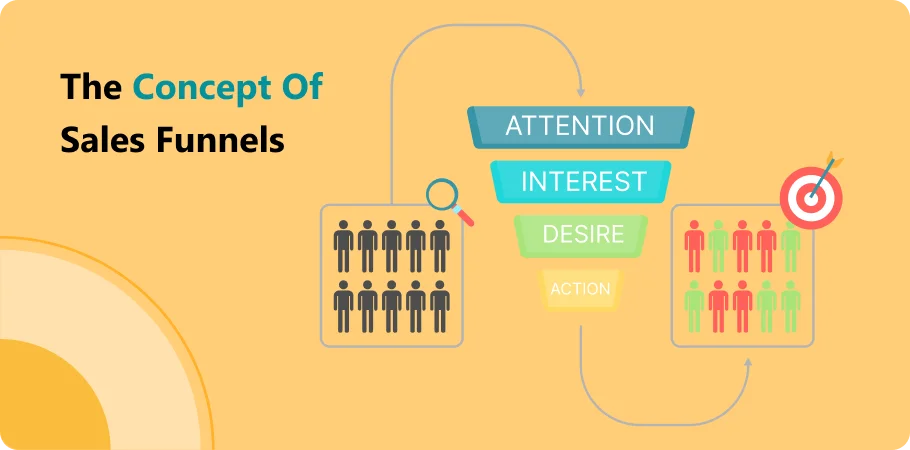
Understanding how your sales and marketing funnel work provides valuable insights into how people decide to buy from you. By identifying where people lose interest or choose not to buy, you can develop better strategies or create awareness to address those issues and convince more people to purchase from your business. In the online business and marketing world, knowing about sales and marketing funnels is crucial for attracting more customers and increasing sales.
A sales funnel acts as a roadmap, showing how people progress from learning about your product to buying it. It’s like a funnel where many people start, but only a few purchase. A sales funnel aims to assist people through each process step, providing them with the information and motivation they need to purchase. Involving your sales teams can provide valuable input and ensure the coordination of marketing and sales efforts.
Sales funnels aren’t just about acquiring new customers, building relationships, and guaranteeing a positive customer experience. By understanding the different stages of the sales funnel—such as when people first discover your product, become interested, desire it, and then make a purchase—most businesses can adjust their marketing to meet customer needs.
It allows them to engage with customers at each stage, provide them with what they need, and ultimately persuade them to buy. So, sales funnels serve as a roadmap for businesses to attract more customers, increase revenue, and keep existing customers satisfied throughout the process.
In simpler terms, a sales funnel shows the steps someone takes to become your customer. For example, many people may walk by if you have a store, but only some decide to come in. Those who come in are at the first stage of the sales funnel. Then, if they show interest in a product, they move to the next stage. Finally, if they like the product enough, they’ll buy it, reaching the last stage of the sales funnel.
The Significance of the Sales Funnel Model in Business
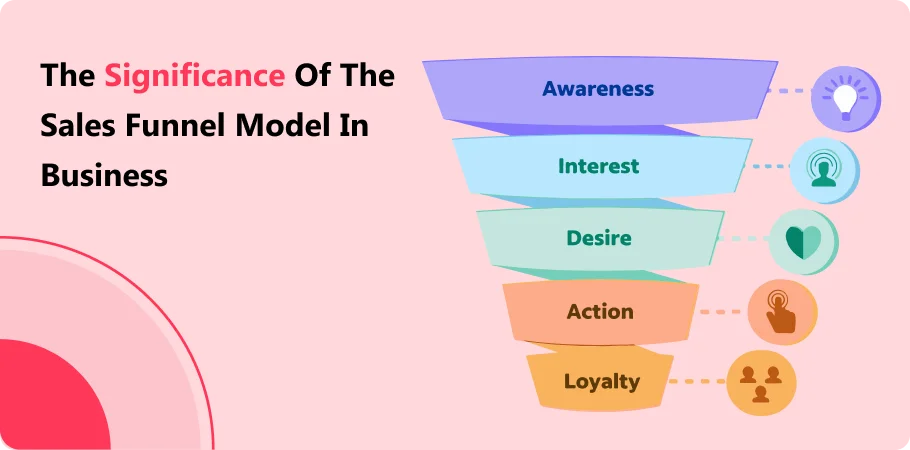
Using a sales funnel in business has unique benefits that can help a company succeed:
- Clear Plan: A sales funnel gives you a clear plan for how to turn potential customer into paying ones. It’s like following a roadmap that guides you through each sales process step.
- Better Organization: With a sales funnel, you can organize your leads based on their stage of the buying journey. It helps you focus on the right people at the right time, increasing your chances of making a sale.
- More Sales: By understanding what your customers need at each stage of the sales process, you can provide the correct information and support to help them purchase, which will lead to more sales and revenue for your business.
- Happier Customers: The sales funnel focuses on making the buying experience smooth and enjoyable for customers. By giving them what they need when they need it, you can create happier customers who are more likely to return and buy from you again.
- Intelligent Decision-Making: The sales funnel provides valuable data about how your customers behave and what they want. It helps you make smarter decisions about how to market and sell your products, leading to business growth.
Using a sales funnel in your business can help you make more sales, keep your existing customers happy, and grow your small business to grow more effectively by attracting new customers.
Delving into the Sales Process
Imagine Alex, a project manager at a small marketing company, searching for ways to make project management more effortless. While browsing online, he spots an ad for project management software. Curious, he clicks the ad and explores the software’s website. He watches demo videos there and grabs a free e-book about better project management.
Alex decides to try the software because he is impressed by what he sees and learns. He signs up for a free trial to see if it fits his team’s needs. During the trial, he attends a webinar to learn more about using the software effectively.
Alex also discovered the company’s YouTube channel, which has helpful videos and customer stories. Plus, he notices Facebook ads sharing success stories from other businesses using the software.
After the next few weeks of using the software, Alex decides it’s worth it. He upgrades to a paid plan with all the features he needs. This journey—from discovering the software to being one of the qualified leads—illustrates how Alex moved through different main stages of the sales funnel, like learning, trying out, and finally deciding to invest in the software for his marketing team. It is how you retain customers.
Sales Funnel Stages:
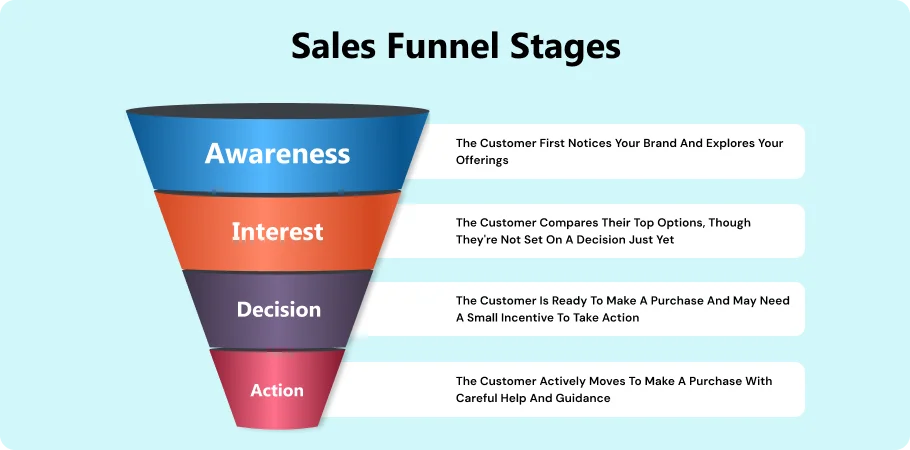
The Sales Funnel Stages typically include:
- Awareness Stage: At this stage, customers become aware of your brand, product, or service, and other Marketing efforts focus on capturing attention through online platforms like social media, content marketing, and advertising. The goal is to generate awareness and generate interest in what you offer.
- Interest Stage: Once prospects know about your brand, the next step is cultivating their interest. It involves providing valuable content, addressing their weak points, and describing the unique value of your offering to attract prospects. Implementing an effective sales strategy helps to engage with qualified prospects on a deeper level and keep them interested in your products or services.
- Desire Stage: As prospects move further down the funnel, they begin to develop a desire for your product or service. It is where you can highlight its benefits, features, and advantages over competitors. The goal is to make your offering irresistible and convince prospects that it’s the best solution for their needs.
- Action Stage: The final stage of the sales process is the decision stage, where prospects take the desired action. It could include purchasing, signing up for a trial, or requesting more information. Sales reps aim to convert leads into paying customers and prompt them to take the next step in their customer journey.
Book a CrmOne Demo
Experience the CrmOne simplicity and power. Our experts will show you the best ways to use it and answer your questions in real time. See how CRMOne fits your needs.
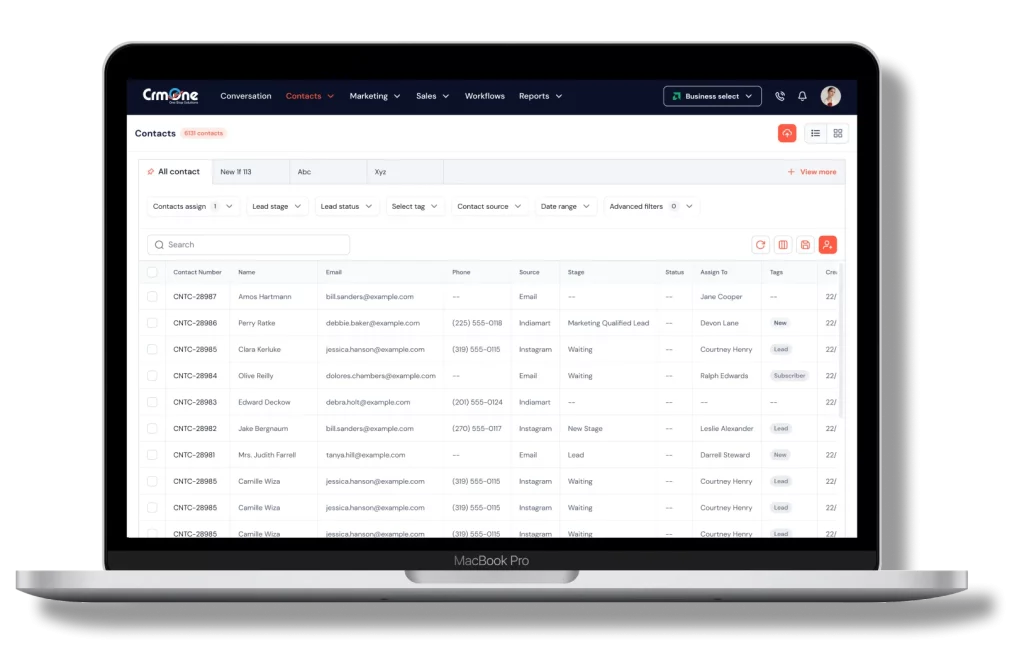
Understanding the Components of a Sales Funnel
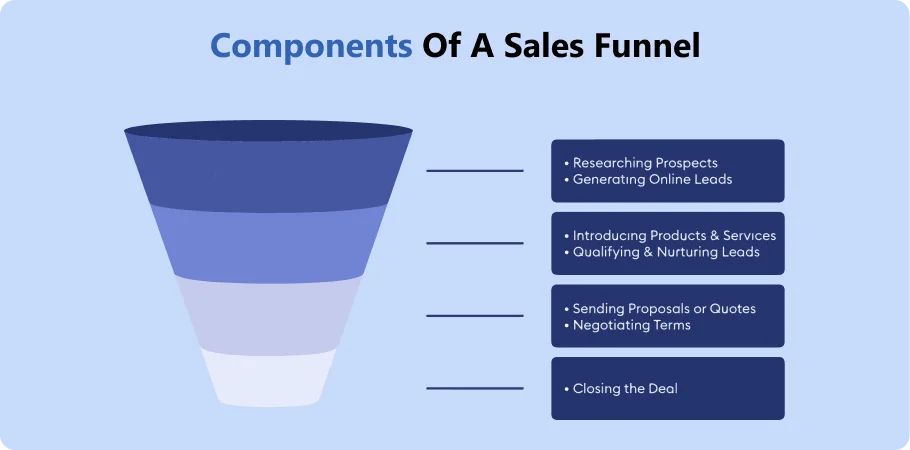
A proper sales funnel consists of several key components, each playing a crucial role in guiding prospects through the customer journey:
- Top of the Funnel (TOFU): It is where people first hear about a product or service. It’s like saying “hello” to many people and getting their attention. We use social media, Facebook ads, sales pages, and blogs to get people interested in what we’re offering.
- Middle of the Funnel (MOFU): Now, people are considering whether they want to buy what we offer. It’s like when you’re shopping and comparing different options. Here, we give people more information to help them decide if they want to buy from us. This phase is crucial for nurturing leads and guiding them further along the buyer’s journey, effectively managing the sales pipeline to increase the likelihood of conversion.
- Bottom of the Funnel (BOFU): It is where people are ready to make a decision and buy. It’s like when you’ve made up your mind about which shirt to buy at the store. The decision stage comes under this funnel. Here, we make it easy for people to buy from us. We might offer discounts or make the buying process simple. Understanding these stages helps us guide people from just hearing about us to purchasing from us. It’s like a roadmap for turning curious shoppers into happy customers.
Steps of How to Create Sales Funnel
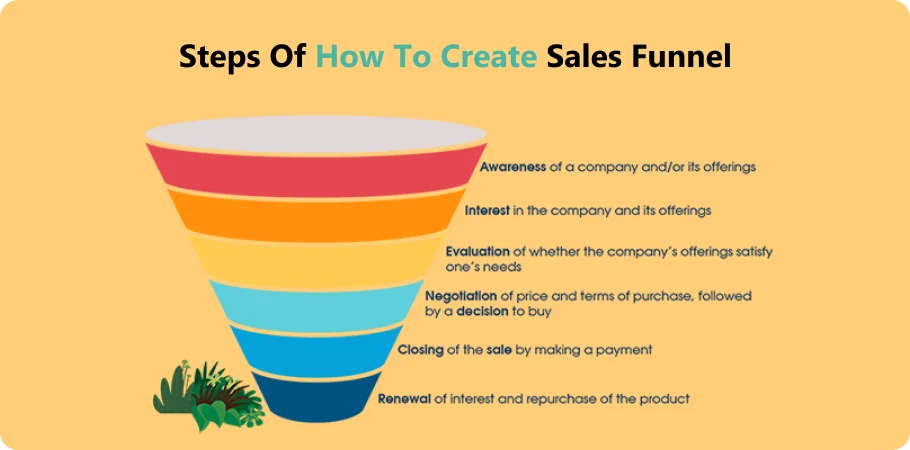
1. Target Audience: Before building sales funnel, it’s crucial to identify and understand your ideal customers. Conduct competitive research to determine their demographics, preferences, pain points, and buying behavior. This information will help you sequence your messaging and marketing efforts to effectively relate to your audience, acquiring leads and qualifying them as leads.
2. Map Out Your Customer Journey: Visualize the different stages prospects go through before purchasing. It could include awareness, consideration, decision, and retention stages, each requiring unique marketing strategies and touchpoints. Understanding the customer journey will help you create targeted content and interactions at each stage of the funnel.
3. Create Compelling Content: Develop high-quality content that educates, informs, and engages your target public at each funnel stage. This could include blog posts, videos, infographics, case studies, and more designed to address their specific needs and interests. Fix your content strategy to create content that aligns with the mindset of prospects at each stage, providing them with valuable information that guides them toward conversion.
4. Optimize Your Website and Landing Pages: Ensure the website’s landing pages are optimized for conversion. It includes clear calls to action, user-friendly navigation, loading time, and mobile responsiveness to provide a seamless browsing experience for your visitors. Design a landing page tailored to each funnel stage, with compelling copy and visuals encouraging action.
5. Implement Lead Generation Strategies: Use a combination of inbound and outbound marketing tips to attract potential customers to your website and capture their contact information. This could include email campaign, social media advertising, content syndication, and search engine optimization (SEO) of landing pages that affect website visitors. Offer valuable incentives such as lead magnets or exclusive offers to motivate visitors to provide their contact details, thereby capturing leads effectively.
6. Nurture Leads with Email Marketing: Nurturing leads involves providing them with educational content, personalized recommendations, and exclusive offers to keep them engaged and moving towards a purchase decision. By dividing your email based on user behavior and preferences, you can deliver relevant messaging that resonates with each prospect. Ensure you nurture and qualify leads effectively to maximize the chances of capturing leads.
7. Track and Analyze Your Results: Monitor critical metrics such as website traffic, marketing campaigns, conversion rates, email open rates, and sales revenue to evaluate the performance of your sales funnel. Use this data to identify areas for improvement and optimize your strategies for better results. Continuously test different parts of your sales funnel, such as messaging, offers, and design, to identify what resonates best with your audience.
Common Mistakes to Avoid for Sales Funnels
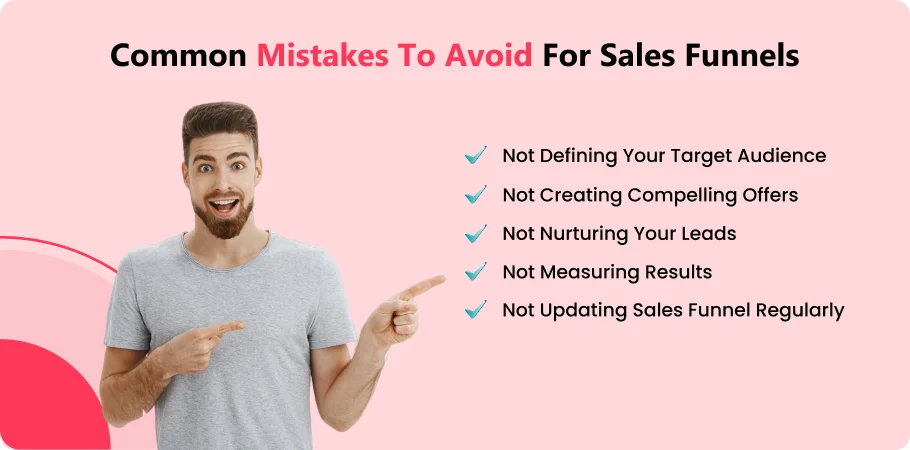
Neglecting Customer Needs:
One big mistake is forgetting what your customers want. Your messages and content might miss the mark if you need clarification on what they need. So, focus on the awareness stage of the sales funnel.
Confusing Messages:
Another problem is that your messaging is unclear. People need to understand what you’re offering to stay and buy from you.
Forgetting to Keep in Touch:
It’s easy to forget to stay in touch with potential customers. But keeping them engaged with emails, content, and follow-ups is critical to getting them to buy.
Not Making Pages Easy to Use:
You’ll lose potential customers if your website pages aren’t easy to use. Make sure your landing page has apparent buttons and is easy to navigate.
Not Tracking Results:
Keeping an eye on how well your funnel is working is crucial. You will only know if your funnel is effective if you track how many people are buying.
Ignoring Mobile Users:
Many people use their phones to shop, so make sure your funnel works well on mobile devices.
Relying Only on Ads:
Ads are great, but if that’s all you’re using, you might miss out on other ways to reach customers.
Not Personalizing Content:
Sending the same message to everyone might not work. Try to personalize your content based on what your customers are interested in.
Not Trying New Things:
Feel free to experiment with different strategies. Testing new ideas can help you find what works best.
Ignoring Feedback:
Lastly, pay attention to what your customers are saying. Their feedback can help you improve your funnel and increase sales.
Conclusion
For an even more streamlined approach, consider integrating CrmOne into your sales strategy. CrmOne is designed to help you create sales strategies, analyze results, and enhance your approach efficiently. With its comprehensive tools for market research, customer behavior tracking, and analytics, CrmOne ensures your sales and marketing efforts are aligned and optimized for the best outcomes. Embrace the power of CrmOne to transform your sales funnel management and take your business growth to new heights.
Create sales strategies, analyze the results, and enhance your approach based on what works best for your unique situation for more prospects. Marketing activities like conducting market research, tracking behavior, and utilizing Google Search and Google Analytics can also provide helpful insights to optimize your sales funnel for better results. Involving your sales team in the process can provide valuable input and ensure alignment between marketing and sales efforts.
Sales funnel management is another aspect of successful funnel creation. It optimizes the various stages of the sales process, from lead generation to conversion. By effectively managing your sales funnel, you can recognize bottlenecks, track customer behavior, and make decisions to improve performance and get better results for your business.
In conclusion, mastering the art of sales and marketing funnel creation is an ongoing customer journey—one that requires dedication, consistency, and a readiness to adapt to changing market conditions. By following the steps outlined in this guide and staying focused on delivering value to your customers, you can create funnels that convert, build long-term relationships, and give growth to your business.
Get started for Free
Start for free today. Boost your sales by clicking the Get Started button. With CRMOne, you can manage leads, sales, and customer service all in one place.
